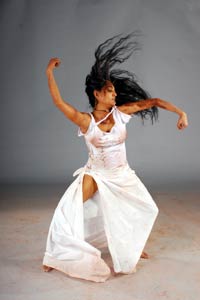|
|
| Reviews |
| |
A FESTIVAL OF INDIAN DANCE
September 01, 2008
|
 
Joseph Aranha
At a kick off party cum press conference at the Consulate General of India in Manhattan last week, the Indo American Arts Council introduced the “Festival of Indian Dance” termed “Erasing Borders” for the first time in New York.
Performances took place at various venues in Manhattan and the city was treated to various facets of Indian dance - both traditional and fusion.
Aroon Shivdasani, the Executive Director of the IAAC and Jonathan Hollander, a Vice President on the Board of Directors brought to life a dream showcasing classical, folk, fusion and innovative dance forms which were all influenced by the arts of India.
The program featured local artists of Indian background, artists from abroad and some even came in from as far away as India so that they could exhibit and perform their works here. Since there is no regular dance festival showcasing Indian dance on a common stage the IAAC seeks to increase awareness about Indian dance by which they hope to develop among one and all, an understanding and appreciation for various facets of Indian dance.
Even though this was a first time venture of its kind there were 75 submissions from the US, Canada, the UK, Singapore and India. There were outdoor and indoor dance performances for four full days, which also included panels, lectures and workshops. Various topics were touched upon like “Expressions and Narratives on Indian dance”, “Issue of Identity, Immigration and Change in Indian Dance”, Reinterpretation of Traditional Movement” to name a few.
Ms Neelam Deo the outgoing Consul General for India praised the IAAC for their work in propagating Indian art and culture. Since her arrival here three years ago Ms Deo had opened up the Consulate and there were at least two dance or music programs every month whereby the Consulate became a home away from home, where people could come and celebrate their culture. This was Ms Neelam Deo’s legacy to the community here, other than making the Consulate more effective in its functioning. She will long be remembered for this.
This years festival showcased 23 different performances by 15 dance troupes and solo performers from around the world. The festival exhibited a magnificent melange of styles and traditions. The educational component of the festival explored the complexities of aesthetics, sensibilities, issues and perspectives of the rich tradition of Indian dance, while at the same time nurturing exciting new dimensions developing in the Indian, American and global contexts.
While each days production was different yet it was designed as a coherent, expressive performance which was interwoven with the others to create one compelling whole.
After the 90 minute programs at the Chase Manhattan Plaza audience members were invited to the raised stage to learn a few movements from the performers themselves. Many of those who joined the performers on stage to get a feeling of what Indian dance was all about were of the younger age groups.
The Bharatanatyam performance by the Sampradya Dance Creations from Canada came close to perfection. They also put on a performance mimicking cricketers in action and did a commendable job of showing what the game was all about while not saying a word. Everything was through action of the body and facial expressions. And that is what held the attention of a western audience, as they sat there trying to fathom what is being said through action. Also the various costumes, jewelry and other adornments worn by the dancers drew praise from the audiences.
The Odissi performance “Pallavi” by the Nayikas Dance Theater Company in the US collaborated with the all male Odissi dance group “Ridrakshya” from India, and as usual put up a very sensuous performance.
Another group that deserves kudos for their performance was the dance team of the Manu Kala Mandir Dance Productions. Shivanai Thakkar and T K Thiruchelwam where their performance highlighted male/female interaction. Their performance at the festival highlighted two important markers - the moment when the male female spirits feel the initial attraction and meet for the fist time, and the moment when, after a period of separation, they reunite and, and like two merging rivers build a stronger, deeper relationship where they compliment each other and become integral halves of a twofold whole.
There were other groups performing Kathak, Kuchipudi, modern and contemporary pieces and by the end of all the activities all over the city on Thursday one came away with the feeling that borders were definitely being erased by the performers, while others felt that the original dance forms were being distorted or diluted and that there was more dilution rather than fusion.
While each days production was different yet they were designed as a coherent, expressive performance which inter-acted with the other to create a compelling whole.
The IAAC must be commended in bringing these varied performers together which only gave the viewers more food for thought as to where the dance world was taking us. The general feeling was that traditional dancers should continue to perform their classical dance form, so that the original was not lost, while the innovators could continue to experiment blending the old with the new.
|
| http://www.sainsider.net/arts1.htm |
| |
|

